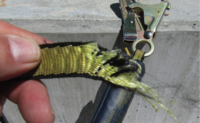The general contractor and structural engineer involved in a November, 2006 crane collapse in Bellevue, Wash., settled a civil lawsuit with the family of the man who died when the 210-ft tower crane’s boom hit his apartment. Details of the settlement, announced April 20, were not disclosed.

The toppled tower crane also damaged Plaza 305, an office building adjacent to the site.
Matthew Ammon, a Microsoft attorney, lived across the street from the Tower 333 site, where the crane was in use. His parents, Kathleen Gaberson and Larry Ammon filed suit in King County Superior Court against Seattle-based firms Lease Crutcher Lewis (LCL), the general contractor, and Magnusson Klemencic Associates (MKA), which designed the crane base for LCL.
They argued the companies were negligent in the crane’s installation and operation. King County Superior Court Judge Michael Trickey had dismissed Northwest Tower Crane Services from the case, stating it was not responsible for any part of the collapse.
“There was no judgment against us but we contributed some of the money in the settlement,” says Jon D. Magnusson, MKA’s chairman and CEO.
In the state Dept. of Labor and Industries (L&I) investigation following the accident, LCL was fined $5,600 for “failure to obtain measurements to ensure crane base deflection limits were not exceeded,” says Bill Lewis, LCL chairman and CEO.
The department also issued a citation and notice, with a $5,600 fine, against MKA. MKA appealed the citation to the state Board of Industrial Insurance Appeals. On Feb. 10, Industrial Appeals Judge Lynn D.W. Hendrickson vacated the citation and notice against MKA “in its entirety,” says the judge’s decision.
Subsequently, the state attorney general’s office filed a motion for reconsideration of the judge’s ruling, says Magnusson. In early April, the three-member Board of Industrial Insurance Appeals voted unanimously to uphold the judge’s ruling, he says.
As part of the civil suit, LCL brought action against MKA. “The whole issue arose when the crane was first erected because it was designed to be immediately tied back to the core” but wasn’t, says Magnusson, who maintains the L&I investigation missed the actual cause of the collapse. The crane base was designed assuming a tie-in to the building frame in the initial configuration and was built without one, he says. The reason for this is the subject of the dispute between LCL and MKA, he adds.
The collapse of the crane prompted the state legislature to enact new laws establishing a construction-crane-certification program and a crane-operator-certification program, which will be administered by L&I. L&I specifically asked that the new construction-crane legislation include a provision that, in any nonstandard tower crane base, an independent professional engineer must review and approve the plans.


Post a comment to this article
Report Abusive Comment